In the aftermath of the 2008 global financial crisis, trust in traditional financial institutions was at an all-time low. Investors, wary of human error and the high costs associated with financial advisors, sought alternatives, and that’s when the concept of robo-advisory models emerged.
A robo-advisor is a digital platform that leverages algorithms and automation to offer investors personalized investment advice and portfolio management. A robo-advisory represents an online investment-management service with little or no human input.
The COVID-19 pandemic further accelerated their growth, with retail investors and fund managers taking to online forms of investing amidst a heavily restricted physical environment. Against this backdrop, as well as the continued focus by brokerage firms on digitalization, robo-advisory services garnered a strong business appeal: low fees, ease of access, and a data-driven approach to investment management.
By 2022, the assets under management (AUM) by robo-advisory models in the U.S. alone had surged to over $460 billion, with millennials shifting their retirement savings to robo-advisor accounts. The industry is estimated to grow at a compound annual growth rate (CAGR) of 29.7 percent between 2023 and 2030.
Tracing the Evolution of Robo-advisory Models
Robo-advisors initially offered basic portfolio recommendations based on user input through online questionnaires. However, they lacked depth and required users to execute trades and manage their portfolios manually. The subsequent iteration, Robo-Advisor 2.0, automated more processes, including integrated investment accounts and direct order execution, maintaining human oversight in key decision-making areas.
The current generation of robo-advisors integrates advanced algorithms for investment decision-making and portfolio rebalancing, supported by professional fund managers to ensure a blend of automation and human expertise.
Brokers Offering Robo-advisory Services: What Should They Consider?
When brokerages consider adding robo-advisory services to their suite of offerings, they’re tapping into a powerful trend: personalized, data-driven investment strategies at scale. But integrating these automated services isn’t just a plug-and-play operation; it requires a sophisticated approach to technology, compliance, and client engagement.
- Technology Infrastructure: Brokers will need to upgrade their tech infrastructure to support AI and ML algorithms capable of handling large volumes of data and complex computations. Brokerages use Big Data tools like Hadoop or Spark, perfect for chewing through massive datasets to extract actionable insights. Vanguard’s cloud-based infrastructure powers their robo-advisory services, enabling them to manage hundreds of thousands of personalized portfolios efficiently. Another example is Betterment’s deployment of ML algos to automate asset allocation and tax-loss harvesting strategies.
- Regulatory Compliance: Brokerages must ensure that automated advisory services comply with financial regulatory standards set by the SEC and FINRA, incorporating robust risk management frameworks and transparent fee structures. Under FINRA, brokers must adhere to a fiduciary duty that ensures they act in the best interest (Reg BI) of their clients. Robo-advisors must be designed to align with this duty, making recommendations based on optimal client outcomes rather than potential brokerage profits. While working with our customer, a leading Wall Street broker, we adopted a compliance-first approach to building a robot advisory/autopilot module into their core portfolio management offering. This helped our client’s customers optimize their investment returns through continuous and dynamic rebalancing (while also maintaining near-zero idle balances to enhance capital utilization).
- Customer Service and Education: Brokers must educate clients about the benefits and limitations of robo-advisors and provide ongoing support to enhance customer trust and engagement. Brokers must also communicate the algorithmic nature of robo-advisors, including how they automate asset allocation based on predefined criteria and real-time market data. Transparency about the process enhances trust, and clients are more likely to invest in services that offer complete clarity on their operational methodologies.
Expert Take
Robo-advisors must evolve to not only crunch numbers but also interpret complex financial scenarios in a context that aligns with individual client goals. The technology is undoubtedly there—robust AI frameworks capable of deep learning and predictive analytics are already transforming data processing. However, the future lies in the strategic deployment of AI and ML to create truly personalized investment experiences.
Can robo-advisors interpret life changes, market fluctuations, and individual risk appetites in real time to offer actionable insights? That’s the answer breakages need to go after. Imagine a robo-advisor that’s as nuanced and perceptive as a seasoned financial planner. Let’s say you are a dedicated vegan and advocate for sustainable living. Instead of merely keeping standard financial indices, your investment app’s algo digs deeper, interpreting snippets of your life from your social media interactions (likes, comments, and other indicators) to tailor a portfolio that emphasizes ESG investments, which resonate with your environmental values.
This level of personalization ensures that when you look at your investment growth, you see not just financial returns but a reflection of your contributions towards a cause you deeply care about!
The real competitive advantage for brokers will stem from their ability to use robo-advisory models, which use simple data points to craft actionable insights, transforming every recommendation into a conversation that ties back to an investor’s values.


